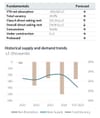NEWBURGH—Non-profit research firm Hudson Valley Pattern for Progress released a report on May 3 that chronicled the Hudson Valley’s population loss during the height of the COVID-19 pandemic in 2019 and 2020. The region lost 4,845 people due to migration to locations outside of the Hudson Valley.
The Pattern for Progress report points out, however, that out-migration net loss is not anything new to the Hudson Valley since the region has lost people to migration 24 of the last 25 years, accounting for a population loss totaling more than 134,505 residents who have packed their bags for neighboring states and the South over that quarter of a century.
Rural Hudson Valley counties registered relatively large population gains from migration as people moved north from the New York City metro area to escape density during the pandemic’s early days. Those gains, however, were offset by large losses of population in Rockland and Westchester counties, which lost a combined net of 9,581 people to outward migration. It should be noted that the region gained a net of 31,258 people in 2020-2021 who moved from New York City into the Hudson Valley. In 2019-2020, the region posted a net gain of 33,394 people who moved from New York City to the Hudson Valley region.
Pattern officials noted that while the data does not show how many people stayed from the first wave (2019-2020), it is fair to estimate that the Hudson Valley gained a net of approximately 60,000 people from New York City during the brunt of the pandemic. Pattern added that the data continue to show a north-south divide for migration.
“Migration continues the reshape of the composition of the Hudson Valley and put stress on many of the systems that our civic society depends on,” Hudson Valley Pattern for Progress CEO Adam Bosch said. “The data analyzed in our report underscore a painful fact: our region has lost population to migration for 24 of the last 25 years. This steady loss of people strains our workforce and businesses, our schools, our system of taxation, and other institutions that allow our communities to survive and thrive. Leaders at every level must examine the complex mix of factors that are causing more people to leave the Hudson Valley so that we can preserve a strong future for our region.”
The “Moving In, Moving Out” report examined a new set of migration data released in the final week of April by the Internal Revenue Service. The data utilized information from tax returns to track domestic and international migration throughout the United States. The data are provided on a county-by-county basis, which allowed Pattern to analyze the inflow and outflow of people for each county in the Hudson Valley, Pattern for Progress officials stated.
The IRS migration data are considered among the most accurate information for tracking the movement of people throughout the United States. The latest set of data is from tax returns filed with the IRS during calendar years 2020 and 2021. Returns received in 2020 represent migration that happened in 2019; and returns received in 2021 represent migration in 2020. Therefore, the data in Moving In, Moving Out show migration trends during the height of the COVID-19 pandemic.
Pattern examined data from the nine-county region that includes Columbia, Dutchess, Greene, Orange, Putnam, Rockland, Sullivan, Ulster and Westchester counties.

SOURCE: HUDSON VALLEY PATTERN FOR PROGRESS
Some of the key takeaways from the Pattern for Progress report included:
• The region gained 104,071 people and lost 108,916 because of migration in 2019-2020, for a net loss of 4,845 people. Although seven out of our nine counties gained population from migration, large losses in Rockland County and Westchester County more than offset the gains to the north. Rockland and Westchester lost a combined net of 9,581 people to outward migration, an outflow that underscores the strong desire to move away from density during the pandemic, the report stated.
• Communities south of I-84 generally lost population or stayed flat, while communities to the north saw a relatively large inflow of new residents. Again, these data highlight the movement away from density and into rural towns and smaller cities and villages. This trend was well documented in real estate data that showed people leaving high-population areas because they feared that density put them at a greater risk of contracting the novel coronavirus.
• Migration affects counties on a proportional basis. Several of the less populated Hudson Valley counties saw large influxes of people from migration. For example, more than 1% of the total population in Sullivan and Greene counties came from a single year of migration.
• A large number of people from the Hudson Valley continue to move just into bordering states. In fact, 12,841 people from the region moved into the bordering counties in Connecticut, Massachusetts, New Jersey and Pennsylvania during the last reporting period. A recent analysis by Pattern found that property taxes in these states are roughly 40%-70% of what Hudson Valley property owners pay.
The data suggest that climate refugees are moving into the region from California. A total of 1,179 people from Los Angeles County have moved into the Hudson Valley from 2018-2020. Many assumed that the growing TV and film industries had attracted these West Coast transplants. While that might be partially true, Pattern stated it has also encountered several people, whom they described as “climate refugees” who moved from Los Angeles during that time because they were tired of water restrictions and wary of fires.
A full analysis of the regional, county-by-county and New York City trends can be found by accessing the report on Pattern’s website.
Hudson Valley Pattern for Progress noted in the report that previous Pattern research reports have found that the consistent outward migration is having a deleterious effect on the Hudson Valley in the form of workforce shortages, school closures, and exacerbating the aging of the region.
“The people leaving our region are, in general, moving to three places. Those who stayed in New York were tending to move to New York City or the Capital District, Hudson Valley Pattern for Progress stated in its report. “Those leaving the state can generally be split into two subsets. One subset has moved to bordering counties in Connecticut, Massachusetts, New Jersey, and Pennsylvania, where property taxes are considerably lower. The second subset has been moving to the South, predominantly to Delaware, Florida, North Carolina, and South Carolina, where lower taxes and housing costs are complimented by warm, snowless weather.
In the report, Pattern for Progress noted that there was a mass migration from New York City to the Hudson Valley after the terrorist attacks on Sept. 11, 2001. However, by 2004, many of those residents had returned to the five boroughs.
“That could happen again, but there are some things that are different in 2023. For one, work-from-home software is more ubiquitous and easy to use. Many who can work from home might decide to stay here a luxury they did not have in 2001,” the report stated. “The Hudson Valley has another factor working in its favor: many of our small cities and villages are in a cycle of reinvestment, with money flowing into revitalization projects in our downtowns. By contrast, many of these same places were deep in a trough of disinvestment when the last wave of New York City migrants moved north more than 20 years ago.”











